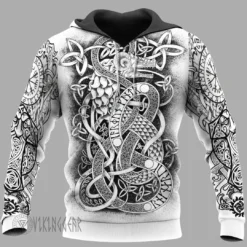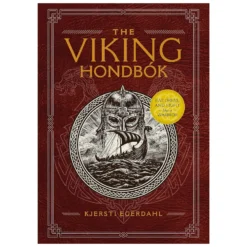Viking Blog
Top 10 Norse Myths That Inspired Modern Stories
Norse mythology has had a significant impact on literature, film, and video games. It has also affected modern philosophy. Its tales of gods, heroes, and cosmic battles have inspired many modern stories. We explore ten influential Norse myths and their impact on modern stories.
1. The Creation of the World
- Myth: The Norse cosmos began with a void, Ginnungagap. The fiery realm of Muspelheim and the icy realm of Niflheim flanked it. The melting ice formed Ymir, the first giant, whose body was later used by Odin and his brothers to create the world.
- Modern Influence: This myth parallels themes in Tolkien’s The Silmarillion. There, primal forces shape the world. Ginnungagap’s primordial void influenced cosmic spaces in franchises like Marvel’s Thor. The first Thor film shows the universe’s creation.
2. Odin’s Sacrifice for Wisdom
- Myth: Odin hung himself from Yggdrasil, the World Tree, for nine days and nights. He sacrificed an eye to drink from the Well of Mímir. This gave him unmatched wisdom.
- Modern Influence: This tale echoes in characters like Gandalf from The Lord of the Rings. Like Odin, Gandalf undergoes a transformative experience. He sacrifices himself, dying and being reborn. He returns with greater knowledge and power. The idea of self-sacrifice for enlightenment also appears in modern stories. In The Matrix, Neo takes the red pill. He sacrifices his comfortable reality for true knowledge.
3. Thor’s Battle with Jörmungandr
- Myth: Thor’s nemesis is Jörmungandr, the World Serpent, whom he fights during Ragnarök. Their battle ends with Thor slaying the serpent but succumbing to its venom.
- Modern Influence: This hero’s doomed fight against evil appears in God of War. There, Kratos faces his own monstrous foes. It also appears in films like Thor: Ragnarok. There, Thor’s fight with Hela mirrors his destined battle with Jörmungandr. Both stories show the hero’s acceptance of their fate. They are willing to fight for the greater good, even if it leads to certain death.
4. Loki’s Schemes and Punishment
- Myth: Loki’s mischief causes many disasters, from Baldur’s death to his monstrous offspring. The gods bind Loki in a cave, where venom drips onto him without interruption until Ragnarök.
- Modern Influence: Marvel’s Loki draws on Loki’s trickster archetype. It portrays a complex antihero who grapples with his identity and actions. His chaos and moral ambiguity show in characters like Batman’s Joker. They embody the unpredictable, destructive nature of trickster figures.
5. The Death of Baldur
- Myth: Loki, in disguise, kills the beloved god Baldur with a mistletoe dart. This starts Ragnarök.
- Modern Influence: God of War (2018) reimagines Baldur’s story. His tragic arc explores immortality, loss, and the father-son bond. The myth’s themes of betrayal and grief echo in Shakespeare’s Hamlet. There, the protagonist grapples with his father’s murder.
6. Ragnarök: The Twilight of the Gods
- Myth: Ragnarök foretells the end of the gods, a cataclysmic battle that reshapes the world. Odin, Thor, and Loki meet their fates. But the cycle of destruction and rebirth continues.
- Ragnarök’s apocalyptic imagery has influenced stories like Game of Thrones. Its “Long Night” and the White Walkers are examples. The theme of cyclical renewal appears in sci-fi franchises like The Matrix. Its destruction creates the chance for a new world.
7. Freyja and the Necklace of the Brísingamen
- Myth: Freyja got the Brísingamen necklace by negotiating with dwarves. This shows her determination and resourcefulness.
- Modern Influence: Freyja’s free spirit has inspired strong female characters in fantasy literature. For example, Éowyn in The Lord of the Rings defies society to fight for her beliefs. The Hobbit echoes with the allure of magical artifacts like the Brísingamen. Both the Arkenstone and the Brísingamen are beautiful, powerful, and drive the story.
8. The Mead of Poetry
- Myth: Odin steals the Mead of Poetry from the giants. It grants eloquence and inspiration to gods and men.
- Modern Influence: This myth inspires themes of divine inspiration and a quest for knowledge. A Greek myth about Prometheus shows this. He steals fire from the gods to give it to humanity. It shows in modern works like Neil Gaiman’s American Gods. It explores ancient deities in the modern world and the power of stories and belief.
9. Fenrir and Tyr’s Sacrifice
- Myth: Fenrir, the monstrous wolf, is bound by the gods through Tyr’s sacrifice of his hand. Fenrir will break free and kill Odin during Ragnarök.
- Modern Influence: Fenrir’s containment and rebellion echo Jurassic Park. It shows that attempts to control powerful creatures will fail, leading to chaos. Tyr’s sacrifice for the greater good echoes in characters like Harry Potter. He confronts Voldemort, fully aware that it may cost him his life.
10. Hel and the Underworld
- Myth: Hel, ruler of the underworld, governs over the souls who die of sickness or old age. The artist depicts her realm as cold and bleak.
- Modern Influence: Hel’s realm has shaped afterlife depictions in works like Hellboy. It features a dark, fantastical underworld. Her character inspired Hela, the antagonist in Thor: Ragnarok. Hela embodies the destructive power and chilling presence of the Norse underworld.
Conclusion
Norse mythology has captivating tales of gods, monsters, and heroes. It still resonates in modern media. These myths endure for their thrilling plots and universal themes. They explore sacrifice, redemption, the fight against fate, and life’s cycles. They remind us that, despite certain endings, there is always hope. To explore Norse mythology, consider the Poetic Edda and the Prose Edda. You could also visit museums on Norse culture and history.































